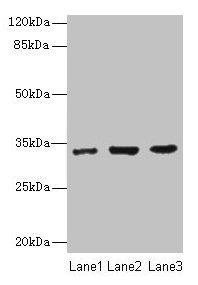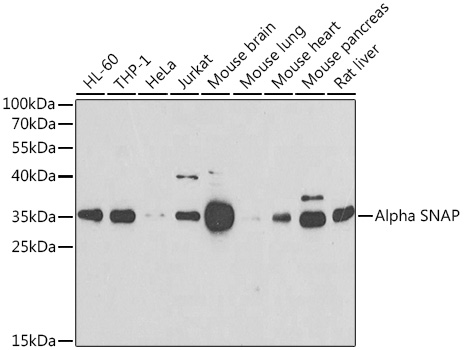alpha SNAP antibody [N2C3]
GTX106626
ApplicationsImmunoFluorescence, ImmunoPrecipitation, Western Blot, ImmunoCytoChemistry, ImmunoHistoChemistry, ImmunoHistoChemistry Paraffin
Product group Antibodies
TargetNAPA
Overview
- SupplierGeneTex
- Product Namealpha SNAP antibody [N2C3]
- Delivery Days Customer9
- Application Supplier NoteWB: 1:500-1:10000. ICC/IF: 1:100-1:1000. IHC-P: 1:100-1:1000. *Optimal dilutions/concentrations should be determined by the researcher.Not tested in other applications.
- ApplicationsImmunoFluorescence, ImmunoPrecipitation, Western Blot, ImmunoCytoChemistry, ImmunoHistoChemistry, ImmunoHistoChemistry Paraffin
- CertificationResearch Use Only
- ClonalityPolyclonal
- Concentration1 mg/ml
- ConjugateUnconjugated
- Gene ID8775
- Target nameNAPA
- Target descriptionNSF attachment protein alpha
- Target synonymsSNAPA, alpha-soluble NSF attachment protein, N-ethylmaleimide-sensitive factor attachment protein, alpha, alpha-SNAP
- HostRabbit
- IsotypeIgG
- Protein IDP54920
- Protein NameAlpha-soluble NSF attachment protein
- Scientific DescriptionThe SNARE hypothesis is a model explaining the process of docking and fusion of vesicles to their target membranes. According to this model, membrane proteins from the vesicle (v-SNAREs) and proteins from the target membrane (t-SNAREs) govern the specificity of vesicle targeting and docking through mutual recognition. Once the 2 classes of SNAREs bind to each other, they form a complex that recruits the general elements of the fusion apparatus, namely NSF (N-ethylmaleimide-sensitive factor) and SNAPs (soluble NSF-attachment proteins), to the site of membrane fusion, thereby forming the 20S fusion complex. Alpha- and gamma-SNAP are found in a wide range of tissues and act synergistically in intra-Golgi transport. The sequence of the predicted 295-amino acid human protein encoded by NAPA shares 37%, 60%, and 67% identity with the sequences of yeast, Drosophila, and squid alpha-SNAP, respectively. Platelets contain some of the same proteins, including NSF, p115/TAP, alpha-SNAP, gamma-SNAP, and the t-SNAREs syntaxin-2 and syntaxin-4, that are used in many vesicular transport processes in other cell types. Platelet exocytosis uses a molecular mechanism similar to that used by other secretory cells, such as neurons, although the proteins used by the platelet and their modes of regulation may be quite different. [provided by RefSeq]
- Storage Instruction-20°C or -80°C,2°C to 8°C
- UNSPSC12352203
References
- Soluble NSF attachment protein receptor molecular mimicry by a Legionella pneumophila Dot/Icm effector. King NP et al., 2015 Jun, Cell MicrobiolRead more
- Cardioprotective Effects of Quercetin in Cardiomyocyte under Ischemia/Reperfusion Injury. Chen YW et al., 2013, Evid Based Complement Alternat MedRead more






